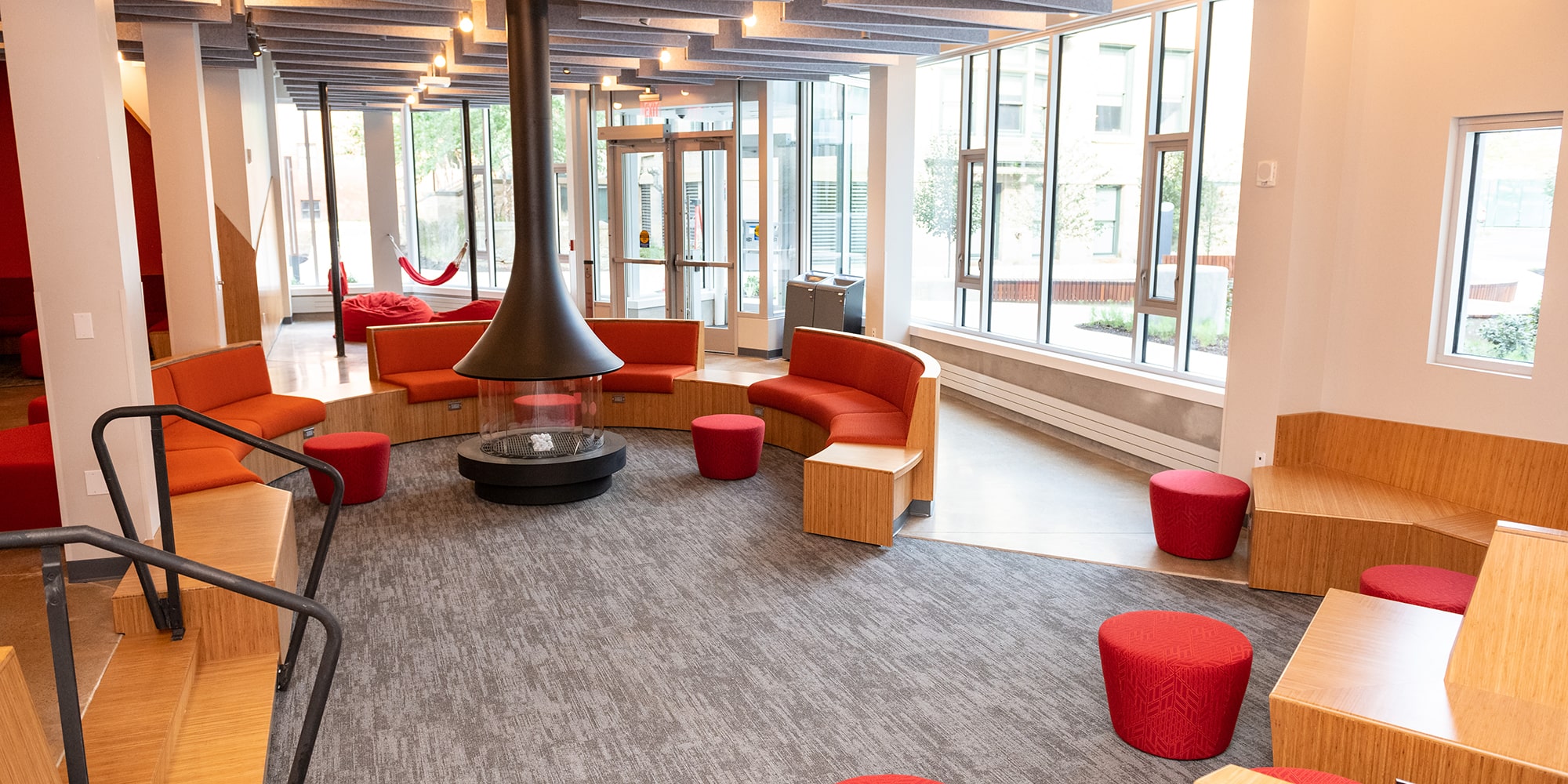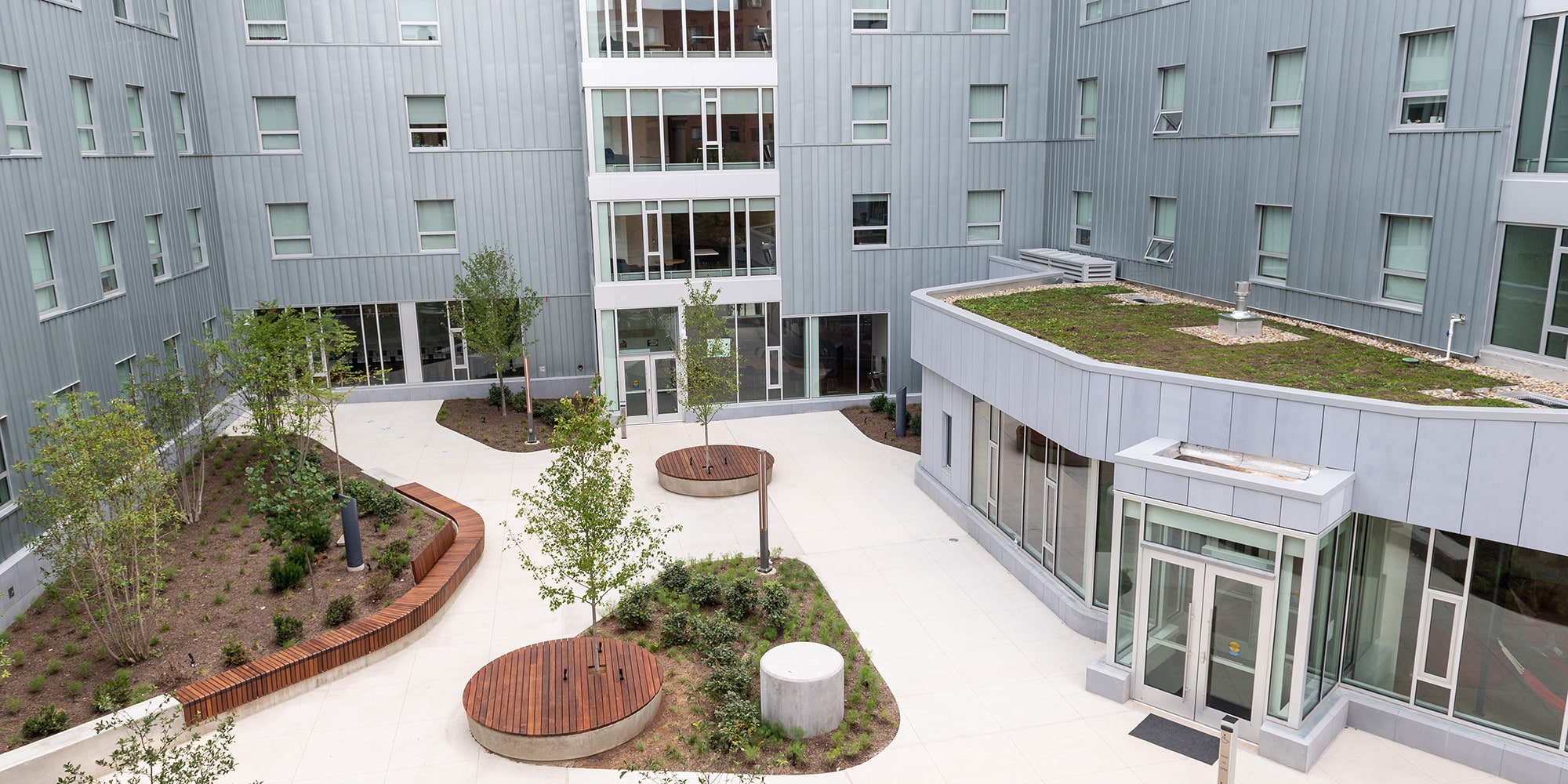The Heart of the Neighborhood: CMU Opens First Commons on Fifth Avenue
By Rachel Marie Latsko
Located in the Fifth Avenue Neighborhood of campus, a new, beautiful 5,000 square foot community space funded by Housing Services has opened its doors to Carnegie Mellon students, faculty and staff to build, strengthen and nurture community and connection.
Adjoined with the new Fifth and Clyde House, a new residence hall that opened in late August, the Fifth Avenue Neighborhood Commons provides a versatile space for musicians, dancers, student organizations and anyone looking to unwind and connect.
The commons is a place where you can practice for your next gig with your band or learn to play piano in between classes in dedicated music spaces dubbed “jam rooms.” You can start your day with some yoga and end it with a late-night practice with your dance crew on the spring-loaded floor in the wellness room.
At the center of the Neighborhood Commons is a hearth — a place for everyone to commune, relax or brainstorm the next great innovation while gazing out onto the building’s peaceful courtyard.
“We’re creating an atmosphere and a culture of a third space on campus — it’s not your classroom, it’s not your bedroom, it’s a place where you can go to feel a sense of community and a sense of home,” said Jesse Koch, the newly appointed associate director of the Cohon University Center and Neighborhood Commons concept.
Koch is no stranger to the student experience. He previously worked in CMU’s Office of Student Leadership, Involvement, and Civic Engagement (SLICE).
“Both my work in SLICE and what I will be doing with the Fifth Avenue Neighborhood Commons is centered around improving the student experience. In this role, I’m shifting to how our students take care of their holistic selves — focusing deeply on their health and well-being,” he said.
To ensure the student perspective was incorporated into the space, Koch and Housing Services Executive Director Tom Cooley enlisted the help of multiple student groups and student representatives throughout the building and construction process.
 At the center of the Neighborhood Commons is a hearth — a place for everyone to commune, relax or brainstorm the next great innovation.
At the center of the Neighborhood Commons is a hearth — a place for everyone to commune, relax or brainstorm the next great innovation.
Lobster Seeking Room to Jam
One of those student representatives is Jackson Bogomolny, a fifth-year master's degree student in the Department of Electrical and Computer Engineering. Since stepping on campus, Bogomolny has made it his mission to give independent and unconventional musicians on campus a place to create, grow and make friends.
Former president of CMU’s Independent Musicians Organization (IMO), Bogomolny finds time when he isn’t working to hang out in the IMO jam room playing the guitar, bass and drums, or introducing the world to “crustacean punk” with “Heavy Lobster,” his band that includes CMU students and alumni.
“While many music rooms at CMU are designed with only classical instruments in mind, or just inaccessible to non-music majors, we wanted to provide all the other musicians on campus with a space meant for them. Any player, any major, any skill level, and any genre should be welcome here,” Bogomolny said. “CMU is encouraging creativity outside of one's academic field, in the interdisciplinary way CMU is known for.”
The Neighborhood Commons is unique in that it encourages a group practice environment. For example, the music rooms are equipped with a keyboard, amps, a drumkit, a speaker and microphone. This is a game-changer for non-music majors and off-campus students whose practice options are limited on campus.
“I'm going to hang out in this commons during the week when I want to practice piano.” — George Whitfield
Senior George Whitfield is a non-music major who is excited to use the new commons.
“I study electrical and computer engineering, with a minor in game design, and like to spread joy and happiness through jazz and electronic music,” said Whitfield, president of CMU’s Jazz Club.
“I'm going to hang out in this commons during the week when I want to practice piano. I'll be in the space frequently on the weekends for Jazz Club jams too. This type of convenient practice space is super helpful as I practice piano during odd hours of the day in between or after classes. I want to use it as much as I can,” he said.
The Neighborhood Model
In addition to the music and wellness spaces, the Neighborhood Commons is equipped with study nooks and a multipurpose room that can hold 30-40 people at full capacity.
A core campus partner that plans to utilize the multipurpose space is Residential Education. Through its housefellows, community advisors (CAs) and resident assistants (RAs), Residential Education will bring the neighborhood model to life.
Fifth and Clyde Housefellow Josh Schaldenbrand is looking forward to developing community through exciting educational initiatives and through the core tenants of cultural competence, social responsibility and well-being.
“The neighborhood model is an intentional concept, and the commons is an intentional space within that physical environment. Having the commons in place says we want to create the space for people to come together, to meet one another and connect, and to engage in all of the things they are passionate about: dance, music, academics, student leadership and engagement within the Fifth Avenue Neighborhood,” Schaldenbrand said.
“I hope that it will become the epicenter of larger events for the Fifth Avenue Neighborhood and also a space where students can connect with each other from all of the buildings in this campus area,” he said.
One of those students eager to impact the neighborhood is Lila Rokanas, a Dietrich College senior studying statistics and machine learning.
On a typical day, you can find Rokanas running around her residential communities (Residence on Fifth, Fifth Neville and Clyde House) as a community advisor (CA), or allocating funds to campus traditions like booth and buggy as treasurer of the Student Dormitory Council (SDC). The SDC is a student organization that acts as a liaison between residential students and housing administrators.
“Having the commons in place says we want to create the space for people to come together, to meet one another and connect, and to engage in all of the things they are passionate about.” — Josh Schaldenbrand
Rokanas has been involved with the Fifth and Clyde Residence Hall and Commons project from the start. Back when Fifth and Clyde was just a parking lot, Rokanas attended the Meet Me at the Hearth dedication event to celebrate the start of construction. Since then she’s given hard hat tours of the residence hall to students, helped pick out furniture for Fifth and Clyde House and attended an ice cream social event for Origins students in her residential community.
“Like CMU, the commons is for everyone,” Rokanas said.
Rokanas and fellow CA and Fifth-Year Scholar Robin Kuo are excited for the potential programming opportunities and collaboration. Kuo, who graduated last semester with degrees in materials science and engineering and engineering and public policy, is using her fifth-year of study working on creating learning resources and community connections for heritage language speakers on campus.
“The other Fifth Avenue CAs and I are looking forward to hosting monthly neighborhood events in the commons, as well as in Fifth and Clyde’s kitchen and courtyard. As we try to lean into the neighborhood model of residential life, I hope this space helps bring that concept to life. We have a unique opportunity in opening the first of many neighborhood commons to come and it’s exciting to get to be a part of that cultural shift,” Kuo said.
As associate director of the Neighborhood Commons concept, Koch hopes the inaugural project can be replicated across campus.
“The current plan is to have a commons central to each residential neighborhood — Fifth Avenue, Morewood and Margaret Morrison — but nothing is ‘cut and paste,’” Koch said. “We hope to create unique experiences that reflect the culture of each neighborhood, while retaining the element of the hearth and central gathering place.”
 The Fifth and Clyde House courtyard is fully equipped with WiFi to ensure students can connect to the internet and work in that space while enjoying the outdoors.
The Fifth and Clyde House courtyard is fully equipped with WiFi to ensure students can connect to the internet and work in that space while enjoying the outdoors.
Using the Commons
The Neighborhood Commons opened this past Monday, September 13. Any CMU student, staff or faculty member can enter the building and programming spaces with their CMU ID-card. Guests are allowed and are the responsibility of their individual hosts.
To keep the feel of a community space rather than a managed campus space, there will be no official staff, like a student sitting at a front desk. You will likely see Koch, as well as RAs and CAs walking through as part of their daily programming.
Reserve programming spaces, like the music and wellness rooms, on 25Live via the dedicated Fifth Avenue Commons website.
Koch’s message to the community: make it your own; come and experience it for yourself.
“Maybe the hammock will be your go-to hangout spot or the hearth. Maybe there’s a secret faculty garage band that has existed for years that can use this space!” Koch said.
